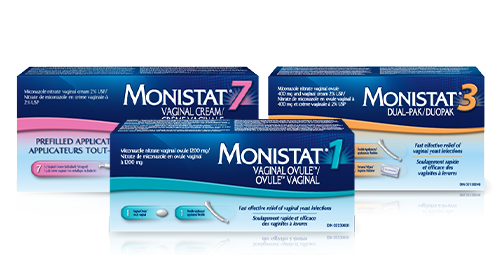How to Prevent & Treat Yeast Infections
Preventing a yeast infection is not always possible. However, there are some steps you can take to reduce your risk of developing one.
Things to Avoid:
- Wearing tight underwear or panty hose as Candida thrive in warm, moist environments
- Douching
- Using items that may inflame the vaginal membrane or upset the normal balance of the vagina, such as:
- Scented detergents or feminine sprays
- Harsh vaginal deodorants
- Perfumed soaps, bubble baths
Good Habits To Practice:
- Change out of wet swim suits and exercise clothes as soon as you can
- Wear cotton underwear
Treatments for Yeast Infections
A fast and effective way to treat a vaginal yeast infection is in the form of antifungal preparations like MONISTAT® products.
MONISTAT® products don’t just relieve the uncomfortable symptoms, they cure most vaginal yeast infections. MONISTAT® products are available over-the-counter, and, come in a variety of effective treatment options including soft, soothing Ovule™ inserts, fast-melting suppositories, and slim, disposable prefilled applicators. So, you don’t have to wait to get the relief you want.
When to See Your Doctor
Sometimes, during the course of treating a yeast infection, it is necessary to contact your doctor. Be sure to talk to your doctor if:
- This is your first vaginal yeast infection
- You experience frequently recurring infections, abdominal pain, fever, foul-smelling or greenish-grayish vaginal discharges (as these may be symptoms of another type of infection)
- There has been no improvement in your symptoms within 3 days of starting treatment or if symptoms last more than 7 days or return within 2 months
- You develop a skin rash, hives, abdominal cramps, or new irritation
- You are taking an oral anticoagulant (blood thinning medication) such as warfarin
- You are pregnant or think you may be or if you are breastfeeding

